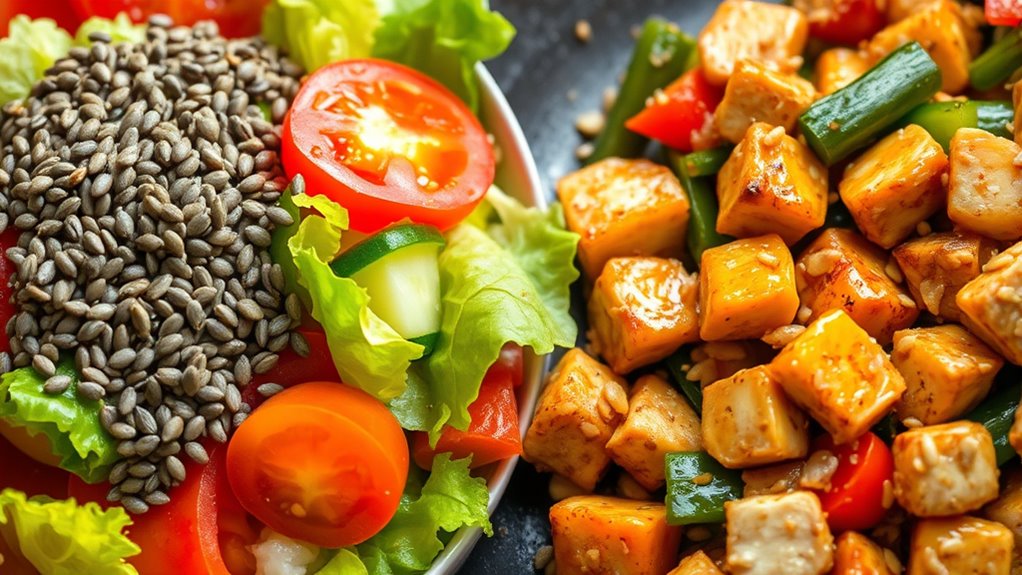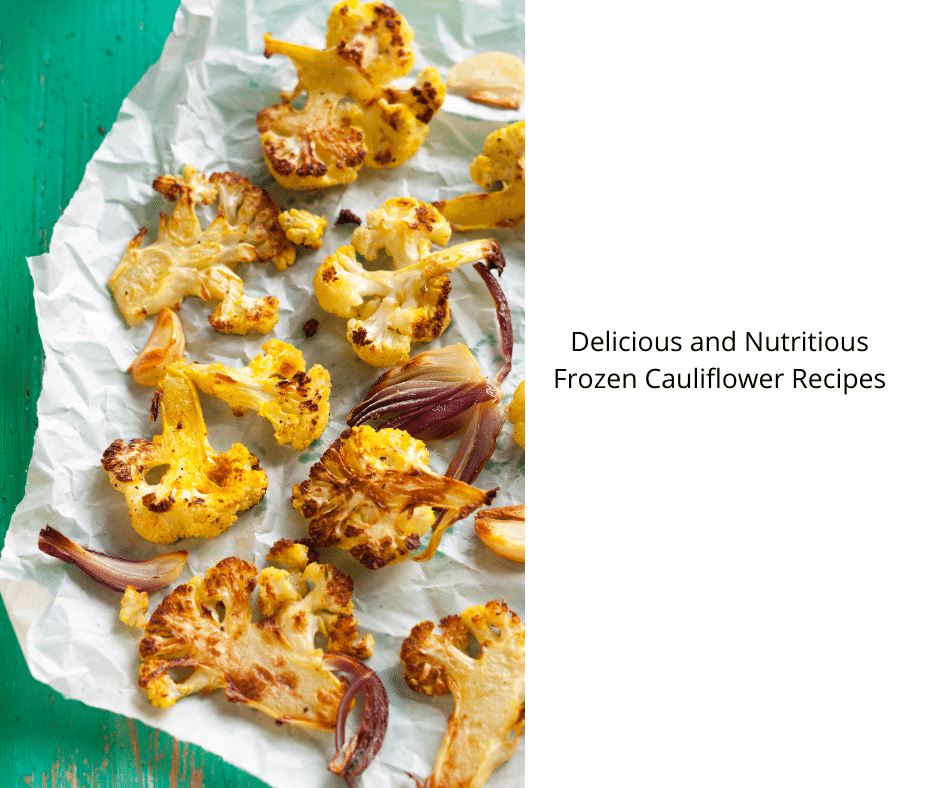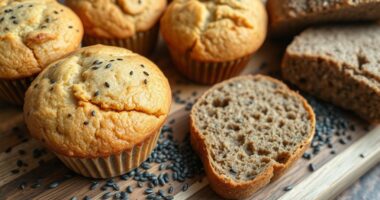Adding chia seeds to your savory dishes is a simple way to boost crunch, nutrition, and flavor. Sprinkle them over salads for added texture, or mix soaked chia into dressings for a gel-like coating that enhances flavor and gut health. Toss them into stir-fries toward the end to enjoy their subtle crunch and absorb flavors naturally. Keep exploring to discover even more creative ways to incorporate chia into your meals.
Key Takeaways
- Sprinkle chia seeds over salads to add crunch, fiber, and omega-3s for enhanced nutrition and texture.
- Mix soaked chia into dressings for a gel-like coating that boosts mouthfeel and flavor complexity.
- Incorporate chia seeds into stir-fries toward the end of cooking to provide a subtle crunch and absorb flavors.
- Use soaked chia as a natural thickener in savory sauces and dips, enriching texture without overpowering taste.
- Combine chia seeds with vegetables in stir-fries to promote satiety and support overall health with added nutrients.

Chia seeds aren’t just for sweet dishes—they’re a versatile ingredient that can elevate savory recipes too. When you incorporate chia seeds into your cooking, you *liberate* a range of benefits that go beyond their reputation as a superfood. Chia seed benefits include added fiber, omega-3 fatty acids, and a boost of protein, all of which support your overall health. These tiny seeds can be a game-changer in savory chia recipes, providing texture, nutrition, and a subtle nutty flavor that enhances the dishes without overpowering them. Whether you’re adding them to salads, stir-fries, or bowls, chia seeds bring a unique crunch that elevates the eating experience.
In salads, sprinkling chia seeds over the top adds a delightful crunch that contrasts beautifully with crisp vegetables and tender greens. You can mix them into dressings or sprinkle directly onto your greens for an extra layer of texture. The seeds absorb some of the moisture from the dressing, creating a slightly gel-like coating that adds a satisfying mouthfeel. This not only makes your salads more interesting but also boosts their nutritional profile, helping you stay fuller longer. Chia seeds can also be soaked beforehand to create chia gel, which acts as a natural thickener or binding agent, perfect for making savory dips or spreads. For instance, blending soaked chia with herbs and spices gives you a creamy, nutritious dip that pairs well with vegetables or whole-grain crackers.
When it comes to stir-fries, chia seeds can be added toward the end of cooking to provide a subtle crunch and added nutrition. Since they don’t need much cooking time, sprinkle them over your stir-fry just before serving. The seeds will absorb the flavors and moisture, enhancing the dish’s texture. Incorporating chia seeds into stir-fry sauces or marinades is another option; the seeds can thicken the sauce naturally, reducing your need for additional thickeners. Plus, the omega-3s and fiber from chia contribute to a balanced meal, supporting your digestion and heart health.
Frequently Asked Questions
Can Chia Seeds Replace Croutons in Salads?
Yes, you can use chia seeds as a replacement for croutons in salads. Chia seed nutrition offers healthy omega-3s, fiber, and protein, making them a nutritious addition. Their versatility allows you to sprinkle or soak them to create a crunchy or gel-like texture, adding a unique element to your dish. While they won’t mimic the crunch of croutons exactly, chia seeds provide a healthy, tasty alternative that enhances your salad’s texture.
How Does Chia Affect Stir-Fry Texture?
Chia seeds add a unique texture to your stir-fry by offering slight crunch and gel-like consistency as they absorb moisture. They enhance texture and promote flavor integration by blending seamlessly into the dish. You’ll notice a subtle, nutty flavor that complements vegetables and proteins, giving your stir-fry a richer, more satisfying mouthfeel. Just sprinkle them in near the end to maximize their beneficial texture enhancement without overpowering the dish.
Are There Any Allergenic Concerns With Chia in Savory Dishes?
You might worry about nut allergy concerns, but chia seeds are allergy-friendly for most, with rare reactions. They’re gluten-free, making them safe for those with gluten sensitivity issues. However, always check packaging for cross-contamination and consult your doctor if you have severe allergies. Chia is generally safe in savory dishes, adding texture without common allergens, so you can enjoy it confidently in your meals.
What Are the Best Chia Seed Preparation Methods for Cooking?
To prepare chia seeds for cooking, you should start with chia seed soaking by immersing them in water or broth for about 10-15 minutes until they form a gel. Alternatively, chia seed grinding turns them into a fine powder, perfect for adding to sauces or doughs. Both methods improve digestibility and texture, making your dishes more flavorful and nutritious. Choose soaking for texture, grinding for smooth incorporation.
How Long Do Chia Seeds Take to Soften in Savory Recipes?
Think of chia seeds as little sponges waiting to soak up flavor. In savory recipes, they typically take about 10-15 minutes of soaking to soften and change texture from firm to tender. During this soaking duration, they expand and develop a gel-like consistency, adding a delightful crunch or thickening your dish. Keep in mind, the longer you soak, the softer they become, making your dish more cohesive and enjoyable.
Conclusion
Now that you know how versatile chia can be, it’s like adding tiny gems to your savory dishes. Whether sprinkled on salads or stirred into stir-fries, chia brings a delightful crunch and nutrition boost. Embrace these little seeds as your secret weapon, transforming everyday meals into vibrant, textured creations. With each sprinkle, you’re painting a more colorful, wholesome plate—turning your kitchen into a canvas of delicious possibilities.








